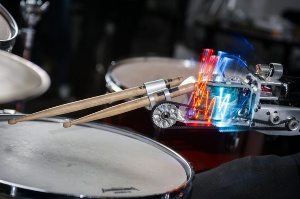Robot Drumming Prosthesis
Engineers at a Georgia Tech laboratory have created a robotic arm that can be attached to amputees, enabling the technology to be embedded into the human body. The robotic arm has motors that can power to drumsticks. The first drumstick is manipulated by the musician’s arms and electromyography (EMG) muscle sensors. The second stick is tuned into the music being played and is able to improvise.
Professor Gil Weinberg developed the prosthetic device for drummer Jason Barnes who was lost his right arm at the elbow after being electrocuted two years ago. Weinberg’s device allows Barnes to control the speed and bounce of his stick with sensors that respond to his bicep muscles.
DNA Technology Merges with RNA to Transport Nanoparticles
A research team led by Jong Hyun Choi, an assistant professor of mechanical engineering at Perdue University, has developed a unique type of molecular motor made from DNA. He then demonstrated the range of it potential by using it to transport a nanoparticle from one end of a nanotube to another.
Inspired by biological motors that have evolved to aid the function of cells, the device is made from a sequence if four chemical bases: adenine, guanine, cytosine and thymine. Though the motor’s mechanism is slower than that of the movement of natural motors, biological motors cannot be controlled, whereas DNA motors can be switched on and off.
Though the project is still in its early stages, potential applications include chemical manufacturing and processing, and drug delivery.
Texts at the Tip of Your Fingers
A new technology called AMP-D or Ambient Pervasive Display can allow you to read your texts or emails from your phone on any nearby surface, even the palm of your hand. Developed by researchers at Ulm University in Germany, the technology is controlled by hand gestures and uses a 3D sensor that enables the projector to adjust its focal length as needed.
Though the technology is a little cumbersome at the moment, the team is working to make it more streamlined. They project that they will have developed a wearable device small enough to be worn around the user’s neck within four years.




















